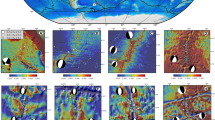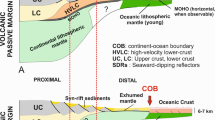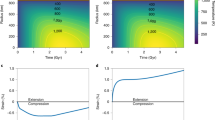Abstract
To first order the elastic thickness Te of the oceanic lithosphere under mid-plate volcanoes increases linearly with the square root of plate age at the time of loading1–4. A large scatter around this simple relationship is observed however, suggesting that factors other than age influence the elastic thickness and produce departure from the first-order trend5. To look at second-order effects, we have conducted a worldwide analysis over the Pacific, Atlantic and Indian oceans and determined Te under sixty volcanoes, applying elastic flexure theory and using as observational constraints, geoid height data from the Seasat satellite. We find that for the three main oceans, the depth of the elastic layer under volcanoes increases with age of plate at loading time t, according to the simple relationship Te = 2.70±0.15 t1/2 (Te in km, t in Myr), except under all of the volcanic chains of the south-central Pacific where this relation does not apply. The elastic layer is found to be much thinner there, and indicates a broad regional anomaly, presumably of thermal origin, well correlated with several other geophysical anomalies reported in this region6–10.
This is a preview of subscription content, access via your institution
Access options
Subscribe to this journal
Receive 51 print issues and online access
$199.00 per year
only $3.90 per issue
Buy this article
- Purchase on Springer Link
- Instant access to full article PDF
Prices may be subject to local taxes which are calculated during checkout
Similar content being viewed by others
References
1. Watts, A. B. J. geophys. Res. 83, 5985–6004 (1978). 2. Watts, A. B. J. geophys. Res. 84, 3817–3826 (1979). 3. Watts, A. B., Bodine, J. H. & Ribe, N. M. Nature 283, 532–537 (1980). 4. Watts, A. B., Karner, G. D. & Steckler, M. S. Phil. Trans. R. Soc. A305, 249–281 (1982). 5. McNutt, M. J. geophys. Res. 89, 11180–11194 (1984). 6. McNutt, M. & Fischer, K. Eos 67, 1220 (1986). 7. Cochran, J. R. Geophys. J. R. astr. Soc. 87, 421–454 (1986). 8. Nishimura, C. E. & Forsyth, D. W. Geophys. J. R. astr. Soc. 81, 389–407 (1985). 9. Cazenave, A. Earth planet. Sci. Lett. 70, 395–406 (1984). 10. Haxby, W. F. & Weissel, J. K. / geophys. Res. 91, 3507–3520 (1986). 11. Van Wyckhouse, R. J. SYNBAPS (Synthetic Bathymetric Profiling Systems) Technical Report (Naval Oceanographic Office, Washington DC, 1973). 12. Cazenave, A. & Dominh, K. / geophys. Res. 89, 11171–11179 (1984). 13. Calmant, S. & Cazenave, A. Earth planet. Sci. Lett. 77, 187–202 (1986). 14. Calmant, S. Earth planet. Sci. Lett, (in the press). 15. Larson, R. L. et al. The Bedrock Geology oj the World (Freeman, New York, 1985). 16. Parsons, B. & Sclater, J. G. /. geophys. Res. 82, 803–827 (1977). 17. Buck, W. R. Nature 313, 775–777 (1985). 18. Buck, W. R. & Parmentier, E. M. /. geophys. Res. 91, 1961–1974 (1986). 19. Craig, C. H. & McKenzie, D. Earth planet. Sci. Lett. 78, 420–426 (1986).
Author information
Authors and Affiliations
Rights and permissions
About this article
Cite this article
Calmant, S., Cazenave, A. Anomalous elastic thickness of the oceanic lithosphere in the south–central Pacific. Nature 328, 236–238 (1987). https://doi.org/10.1038/328236a0
Received:
Accepted:
Issue Date:
DOI: https://doi.org/10.1038/328236a0
This article is cited by
-
High-resolution gravity and geoid models in Tahiti obtained from new airborne and land gravity observations: data fusion by spectral combination
Earth, Planets and Space (2015)
-
Failure of plume theory to explain midplate volcanism in the southern Austral islands
Nature (1997)
-
Volcanism and archipelagic aprons in the Marquesas and Hawaiian Islands
Marine Geophysical Researches (1994)
-
Global coupling of Earth surface topography with hotspots, geoid and mantle heterogeneities
Nature (1989)
Comments
By submitting a comment you agree to abide by our Terms and Community Guidelines. If you find something abusive or that does not comply with our terms or guidelines please flag it as inappropriate.



